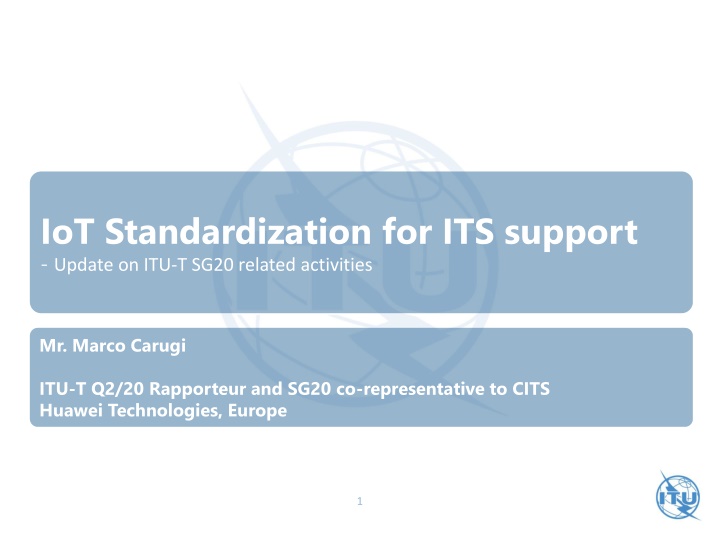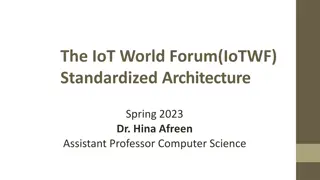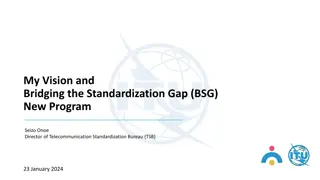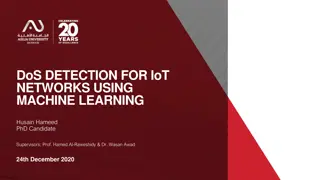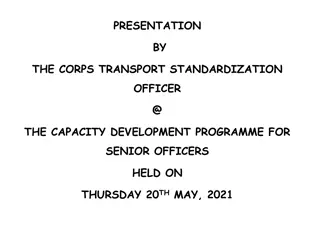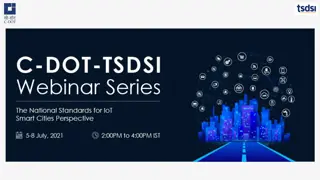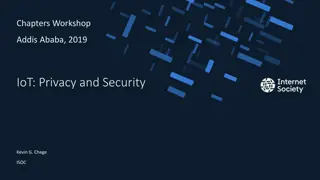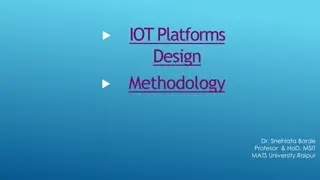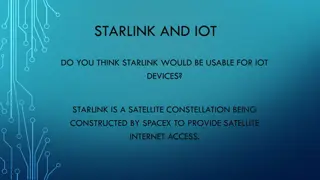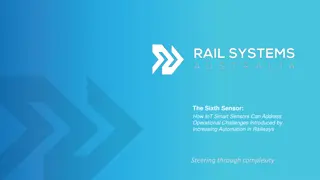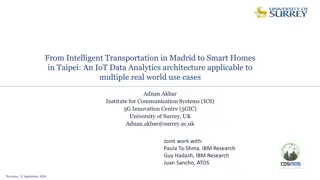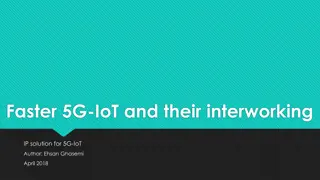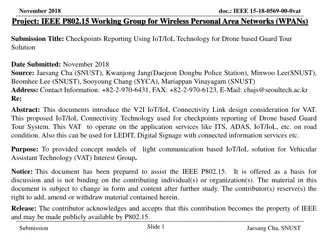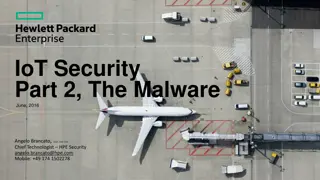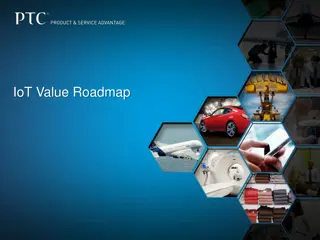IoT Standardization for ITS support
Mr. Marco Carugi, ITU-T Q2/20 Rapporteur, provides an overview of ITU-T SG20's work related to IoT standardization for Intelligent Transportation Systems (ITS). The summary highlights the activities undertaken by SG20 during the 2017-2020 study period, including the development of recommendations, organization of events, and outcomes of the latest meeting. Furthermore, the status of SG20 studies related to IoT for ITS as of September 2020 is outlined, covering a range of topics such as transportation safety services, IoT-based automotive emergency response systems, and unmanned aircraft systems.
Download Presentation

Please find below an Image/Link to download the presentation.
The content on the website is provided AS IS for your information and personal use only. It may not be sold, licensed, or shared on other websites without obtaining consent from the author.If you encounter any issues during the download, it is possible that the publisher has removed the file from their server.
You are allowed to download the files provided on this website for personal or commercial use, subject to the condition that they are used lawfully. All files are the property of their respective owners.
The content on the website is provided AS IS for your information and personal use only. It may not be sold, licensed, or shared on other websites without obtaining consent from the author.
E N D
Presentation Transcript
IoT Standardization for ITS support - Update on ITU-T SG20 related activities Mr. Marco Carugi ITU-T Q2/20 Rapporteur and SG20 co-representative to CITS Huawei Technologies, Europe 1
Summary of ITU-T SG 20 activities In the 2017-2020 study period Developed Recommendations: 74 Revised existing Recommendations: 1 Developed Supplements: 13 Developed other informative texts: 6 Events organized related to IoT and Smart Cities and Communities: over 40 Outcomes of last SG20 meeting, virtual, 6-16 July 2020 (*) Consented Recommendations: 12 Recommendations Determined: 3 Recommendations agreed for Deletion: None Other texts approved: 6 New work items: 19 3 (*) https://www.itu.int/en/ITU-T/studygroups/2017-2020/20/Pages/exec-sum-july20.aspx
SG20 studies related to IoT for ITS Sept 2020 status (1/2) Provisional name Q. Name Type Subject/title Status Approval Hyperlink Requirements of transportation safety services including use cases and service scenarios http://www.itu.int/ITU- T/workprog/wp_item.aspx?isn=13686 Q2/20 Y.4116 Y.TPS-req Rec. Approved Oct-17 Requirements and capability framework for IoT-based automotive emergency response system https://www.itu.int/ITU- T/workprog/wp_item.aspx?isn=14105 Q2/20 Y.4119 Y.AERS-reqts Rec. Approved Feb-18 Framework of Cooperative Intelligent Transport Systems based on the Internet of Things Y.IoT-ITS- framework http://www.itu.int/ITU- T/workprog/wp_item.aspx?isn=13688 Q2/20 Rec. Under study Q2-21 Use cases, requirements and capabilities of unmanned aircraft systems for Internet of Things https://www.itu.int/ITU- T/workprog/wp_item.aspx?isn=14303 Q2/20 Y.IoT-UAS-Reqts Rec. Under study Q2-21 Requirements and capability framework of IoT infrastructure to support network- assisted autonomous vehicles https://www.itu.int/ITU- T/workprog/wp_item.aspx?isn=14958 Q2/20 Y.IoT-AV-Reqts Rec. Under study Q3-21 Accessibility Requirements for Smart Public Transportation Services https://www.itu.int/ITU- T/workprog/wp_item.aspx?isn=14646 Q2/20 Y.ACC-PTS Rec. Under study Q4-20 Minimum set of data structure for automotive emergency response system Approved https://www.itu.int/ITU- T/workprog/wp_item.aspx?isn=14502 Q3/20 Y.4467 Y.AERS-msd Rec. Jan-20 Minimum set of data transfer protocol for automotive emergency response system Functional architecture of network- based driving assistance for autonomous vehicles Functional architecture for unmanned aerial vehicles and unmanned aerial vehicle controllers using IMT-2020 networks https://www.itu.int/ITU- T/workprog/wp_item.aspx?isn=14501 Q3/20 Y.4468 Y.AERS-mtp Rec. Approved Jan-20 Determined (07-20) https://www.itu.int/ITU- T/workprog/wp_item.aspx?isn=14652 Q3/20 Y.4471 Y.NDA-arch Rec. Q4-20 4 https://www.itu.int/ITU- T/workprog/wp_item.aspx?isn=14653 Q3/20 Y.UAV-arch Rec. Under study Q2-21
SG20 studies related to IoT for ITS Sept 2020 status (2/2) Provisional name Type Subject/title Q. Name Status Approval Hyperlink Architectural framework for providing transportation safety services http://www.itu.int/ITU- T/workprog/wp_item.aspx?isn=13677 Q4/20 Y.4457 Y.TPS-afw Rec. Approved May-18 Requirements and functional architecture of smart sharing bicycle service https://www.itu.int/ITU- T/workprog/wp_item.aspx?isn=16675 Y.Smart-SBS Rec. Q4-21 Q4/20 Under study 5
Y.4467 (approved in Jan 2020) Y.4467 Minimum set of data structure for automotive emergency response system Motivation of the study The automotive emergency response system (AERS) for aftermarket devices defined in Recommendation Y.4119 (ex- Y.AERS-reqts) is designed to bring rapid assistance to driver and/or passengers involved in an accident. For the normal operation of the AERS, the accident related data (so-called minimum set of data (MSD)) needs to be sent from automotive emergency detection device (AEDD) to automotive emergency response center (AERC). The MSD includes mandatory information and additional information. The mandatory information is a set of information pieces that must be included in the MSD when the AEDD performs normal operation. The optional information is a set of information pieces that can be additionally included to give more information to AERC. Scope of the Recommendation To define common structure and encoding rule for MSD for the interoperability of AERS. Overview of the MSD for AERS Mandatory information of MSD Optional information of MSD Encoding rule for MSD (compliant with concise binary object representation defined in [IETF RFC 7049]) AERS for aftermarket devices [ITU-T Y.4119] 6
Y.4468 (approved in Jan 2020) Y.4468 Minimum set of data transfer protocol for automotive emergency response system Motivation of the study The automotive emergency response system (AERS) for aftermarket devices defined in Recommendation Y.4119 (ex-Y.AERS-reqts) is designed to bring rapid assistance to driver and/or passengers involved in an accident. For the normal operation of the AERS, an accident related data (MSD)) transfer protocol between automotive emergency detection device (AEDD) in the vehicle and automotive emergency response center (AERC) needs to be defined. Scope of the Recommendation To specify a transfer protocol for MSD transfer operations between AEDD and AERC. MSD transfer protocol parameters Messages types of MSD transfer protocol Sequence of MSD transfer protocol operation The MSD transfer operates over the application layer protocol CoAP [IETF RFC 7252] (the transfer protocol realizes a subset of the CoAP features) 7
Y.4471 (determined at July 2020 meeting) On-board services, with low latency due to the benefits of local processing: a majority of urgent decisions can be conducted in the vehicles directly. Edge services, with persistent support for driving assistance among multiple operators: advanced and complicated applications such as vehicle-to-vehicle/infrastructure coordination can be implemented at the edge. Cloud services, with wide cover range and powerful computing ability: some functions with lower requirements for latency can be implemented in the cloud, e.g., map construction and path planning. Y.4471 Functional architecture of network-based driving assistance for autonomous vehicles Motivation of the study Network-based driving assistance (NDA) can improve safety and efficiency of automated driving with capabilities of cooperative perception and decision. The document specifies a functional architecture of NDA for autonomous vehicles, taking into account the IoT reference model specified in ITU-T Y.4000. Scope of the Recommendation -The functional architecture of NDA for autonomous vehicles -The functional entities to support NDA for autonomous vehicles -The reference points of the functional architecture Cloud Transport Traffic Control High-definition Map Database Path Planning Roadside Data Processing Roadside Data Processing Roadside Data Processing Vehicle Data Processing Vehicle Data Processing Vehicle Data Processing Dynamic High- definition Map Construction Dynamic High- definition Map Construction Dynamic High- definition Map Construction Data Fusion Data Fusion Data Fusion Edge Edge Edge 8 Roadside Infrastructure Roadside Sensor Roadside Sensor
Y.4471: Use cases of NDA (1/3) High definition map It is one key technology to achieve automated driving, considered as a necessary technology for automated driving at SAE L3~L5 levels. It is the carrier of real-time perception of traffic environments, and furthermore provides basic information to support driving assistance for autonomous vehicles. NOTE - When the on-board perception system of autonomous vehicles fails to work, just like the autonomous vehicle is blind , a high definition map (constructed and adaptively updated via the NDA functions) becomes the final basis for driving control, e.g. telling the vehicle the accurate location of the stop line at an intersection, and then improving driving safety and reliability. 9
Y.4471: Use cases of NDA (2/3) Vehicle coordination Based on the relation of vehicles analysed by NDA, some scenarios of vehicle coordination can be realized in order to improve driving safety and traffic efficiency. 10
Y.4471: Use cases of NDA (3/3) Vehicle and road coordination Numerous roadside infrastructures are employed to support automated driving [Note: the European Road Transport Research Advisory Council (ERTRAC) has defined the infrastructure support levels for automated driving (ISAD)]. NDA collects data from roadside infrastructures and analyses the relation of vehicles and road. Some scenarios of vehicle and road coordination can be realized in order to improve driving safety and traffic efficiency. 11
Y.ACC-PTS (planned for consent at 6/11/2020 WP1/20 meeting) Y.ACC-PTS Accessibility requirements for smart public transportation services Motivation of the study The concept of accessibility in public transportation services have been mainly concerned in eliminating physical barriers such as adopting accessible trains and buses that allows a wheelchair accessibility by mechanical lowering-entrance floors. In smart public transportation services, the use of Internet of Things (IoT), when properly designed, may increase accessibility of public transportation services by providing access of information and physical accessibility. The IoT can be used to create tools for persons with many types of disabilities and specific needs, including physical, visual, hearing and cognitive disabilities. In order for the smart transportation services to appropriately provide accessible services, information of accessibility profiles must be agreed upon in advance. Such accessibility profiles should basically include information on accessibility needs while traveling on public transportation services. Scope of the Recommendation The Recommendation specifies accessibility requirements for smart public transportation services. Accessibility requirements for smart public transportation services for persons with disabilities, persons with age-related disabilities and those with specific needs to utilize the benefits of IoT applications and services. Accessibility profiles for accessible smart public transportation services. The study builds over the already approved Rec. Y.4204 (2019) Accessibility requirements for Internet of things applications and services 12
Y.ACC-PTS cont. Summary of IoT applications and services accessibility requirements [ITU-T Y.4204] 13 The 2-layer structure of accessibility requirements [ITU-T Y.ACC-PTS]
Next SG20 events (virtual) 2-6 Nov 2020: WP1 RGM (2-5), WP1 (6) 16 Dec 2020: only for decision on TAP Recs determined at July 2020 meeting Thank you! http://itu.int/go/tsg20 Contact: tsbsg20@itu.int marco.carugi@gmail.com 14
